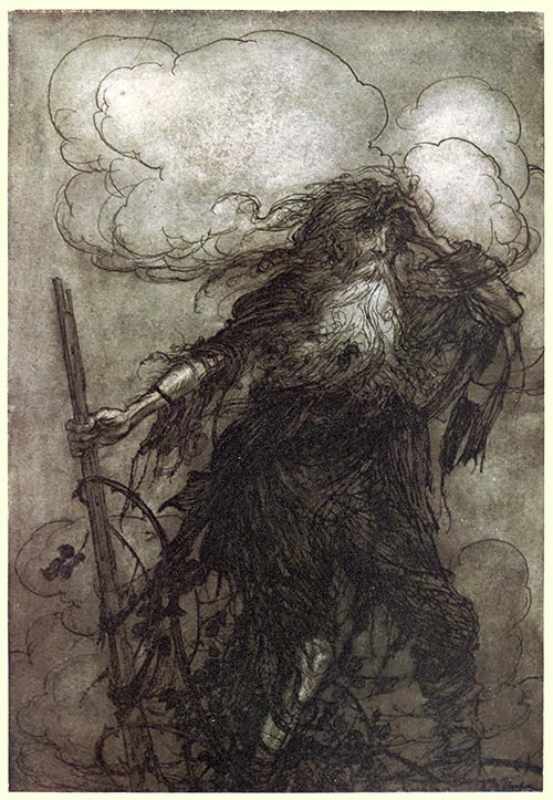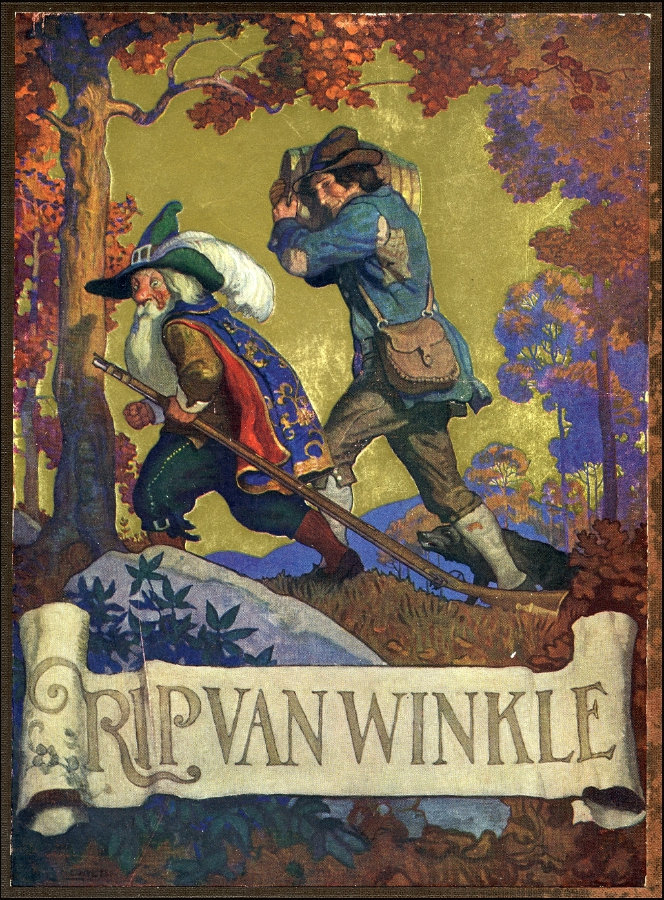Rip Van Winkle, a Dutch-American man with a habit of avoiding useful work, lives in a village at the foot of New York’s Catskill Mountains in the years before the American Revolution. One autumn day, he goes squirrel hunting in the mountains with his dog Wolf to escape his wife’s nagging. As evening falls, he hears a voice calling his name and find a man dressed in antiquated Dutch clothing and carrying a keg. Rip helps the man carry his burden to a cleft in the rocks from which thunderous noises are emanating; the source proves to be a group of ornately dressed and bearded men playing nine-pins. Not asking who these men are or how they know his name, Rip joins them in drinking from the keg he has helped carry and soon becomes so intoxicated that he falls asleep. Rip awakens on a sunny morning, at the spot where he first saw the keg-carrier, and finds that many drastic changes have occurred; his beard is a foot long and has turned gray, his musket is badly deteriorated, and Wolf is nowhere to be found. Returning to his village, he discovers it to be larger than he remembers and filled with people in unfamiliar clothing, none of whom recognize him. When asked how he voted in the election that has just been held, he declares himself a loyal subject of King George III, unaware that the American Revolution has taken place in his absence. He learns that many of his old friends were either killed in the war or have left the village, and is disturbed to find a young man who shares his name, mannerisms, and younger appearance. A young woman states that her father is Rip Van Winkle, who has been missing for 20 years, and an old woman recognizes him as Rip. The young woman and the young Rip are his children, and the former has named her infant son after him as well. Rip discovers that his wife has been dead for some time, but is not saddened by the news. He learns that the men whom he met in the mountains are rumored to be ghosts of the crew of the Halve Maen (Half-Moon), captained by English sea explorer Henry Hudson. His daughter takes him into her home, and he soon resumes his usual idleness and begins telling his story to every stranger who visits the village. The tale is solemnly taken to heart by the Dutch settlers, particularly by the children who say that, whenever thunder is heard, the men in the mountains must be playing nine-pins.
| Alias Rip Van Winkle |
| Real Names/Alt Names Rip van Winkle |
| Characteristics Time Traveler, Literary Characters, Romantic Age |
| Creators/Key Contributors N. C. Wyeth, Washington Irving |
| First Appearance The Sketch Book of Geoffrey Crayon, Gent. #1 (1819) |
| First Publisher C. S. Van Winkle |
| Appearance List Literary: The Sketch Book of Geoffrey Crayon, Gent. #1 (1819), Rip van Winkle; or, The Demons of the Catskill Mountains!!!: A National Drama, in Two Acts (1825), Rip Van Winkle (1828), Rip Van Winkle, a Legend of the Catskills: A Romantic Drama, in Two Acts (1850), Rip Van Winkle: An Original, American, Comic Opera, in Three Acts (1855), Rip Van Winkle (1865), Rip Van Winkle and His Wonderful Nap (1870), A Young Rip Van Winkle: An Original Burlesque (1876), Rip Van Winkle: A Sun Myth, Rip Van Winkle (1880), Rip Van Winkle (1908), When Santa Claus Went to the Front (1918), Rip Van Winkle: Folk‐Opera in Three Acts (1919), An Australian Rip Van Winkle (1921), Rip Van Winkle’s Dream (1947). Movies: Rip Van Winkle (1903), Rip’s Dream (1905), Rip Van Winkle (1910), Rip Van Winkle (1912), Rip Van Winkle (1921). Comics: World Famous Stories #1, Hit Comics #52. |
| Sample Read Rip Van Winkle [PG] |
| Description Rip Van Winkle, a Dutch-American man with a habit of avoiding useful work, lives in a village at the foot of New York’s Catskill Mountains in the years before the American Revolution. One autumn day, he goes squirrel hunting in the mountains with his dog Wolf to escape his wife’s nagging. As evening falls, he hears a voice calling his name and find a man dressed in antiquated Dutch clothing and carrying a keg. Rip helps the man carry his burden to a cleft in the rocks from which thunderous noises are emanating; the source proves to be a group of ornately dressed and bearded men playing nine-pins. Not asking who these men are or how they know his name, Rip joins them in drinking from the keg he has helped carry and soon becomes so intoxicated that he falls asleep. Rip awakens on a sunny morning, at the spot where he first saw the keg-carrier, and finds that many drastic changes have occurred; his beard is a foot long and has turned gray, his musket is badly deteriorated, and Wolf is nowhere to be found. Returning to his village, he discovers it to be larger than he remembers and filled with people in unfamiliar clothing, none of whom recognize him. When asked how he voted in the election that has just been held, he declares himself a loyal subject of King George III, unaware that the American Revolution has taken place in his absence. He learns that many of his old friends were either killed in the war or have left the village, and is disturbed to find a young man who shares his name, mannerisms, and younger appearance. A young woman states that her father is Rip Van Winkle, who has been missing for 20 years, and an old woman recognizes him as Rip. The young woman and the young Rip are his children, and the former has named her infant son after him as well. Rip discovers that his wife has been dead for some time, but is not saddened by the news. He learns that the men whom he met in the mountains are rumored to be ghosts of the crew of the Halve Maen (Half-Moon), captained by English sea explorer Henry Hudson. His daughter takes him into her home, and he soon resumes his usual idleness and begins telling his story to every stranger who visits the village. The tale is solemnly taken to heart by the Dutch settlers, particularly by the children who say that, whenever thunder is heard, the men in the mountains must be playing nine-pins. |
| Source Rip Van Winkle – Wikipedia |






